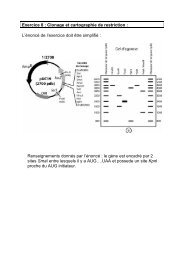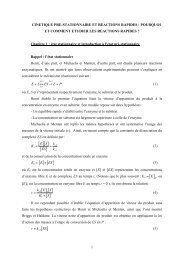Table Of Contents
Table Of Contents
Table Of Contents
Create successful ePaper yourself
Turn your PDF publications into a flip-book with our unique Google optimized e-Paper software.
3.5 Y-axis Calibration Check<br />
It is recommended that the y-axis calibration be checked every few months to ensure<br />
accurate data. The automatic calibration check routine will send a series of pulses to the cell<br />
heaters, dissipating a known power. The offset in the DP as a result of this power is analyzed in<br />
comparison to the correct DP offset.<br />
Make sure the cells are clean, and fill both cells with degassed, distilled water. Load the<br />
titration syringe with water and insert it into the sample cell. It is recommended that Origin for<br />
real-time data be enabled.<br />
To begin the y-axis calibration check procedure select iTC 200 software menu “ITC =><br />
Start ITC Calibration Run => Y Axis Check”. Once the menu has been selected, the Calibration<br />
Pulse Setup Window will appear. This window allows the calibration pulses to be modified.<br />
Individual pulse parameters are entered by first selecting a pulse or multiple pulses, then entering<br />
the desired parameter value into the pulse parameter boxes (Calibration Power, Pulse Duration<br />
and Pulse spacing). Users are encouraged to simply use the default y-axis calibration<br />
parameters. After the run and pulse parameters are entered, clicking on the “Start Run” button<br />
will start the run. The ITC will equilibrate in the same manner as it would during a titration<br />
experiment.<br />
If creating customized calibration parameters, users must be aware of the DP range limits<br />
when setting reference power and pulse sizes. The reference power must be high enough to<br />
allow all pulses without hitting saturation, and if a pulse size is too small, it can show abnormally<br />
high error.<br />
46
















